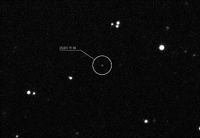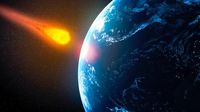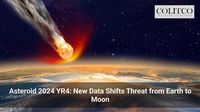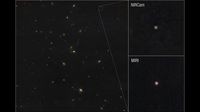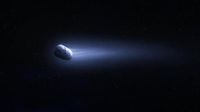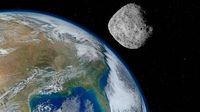A large asteroid, once feared to collide with Earth in 2032, now poses a near 4% chance of impacting the Moon. The asteroid, named 2024 YR4, caught the attention of scientists after its potential to cause significant damage to Earth was raised. NASA’s latest observations, conducted by the James Webb Space Telescope, offer fresh insight into the asteroid’s future trajectory.
Initial Concerns and Earth Impact Risk
In February 2024, the possibility of 2024 YR4 striking Earth caused alarm in the planetary defense community. Initial calculations suggested a 3.1% chance of impact on December 22, 2032. This would have made it the highest recorded risk for an asteroid colliding with Earth. Following swift observations, NASA confidently ruled out the possibility of an Earth impact. However, as the Webb telescope gathered more data, the asteroid’s potential to strike Earth was reduced to near-zero.
New Data Increases Risk to the Moon
The updated findings show that 2024 YR4 could instead crash into the Moon. The current probability of the asteroid impacting Earth’s satellite is 3.8%. NASA confirmed there is still a 96.2% chance it will miss the Moon. This risk continues to rise as further observations are conducted. The European Space Agency’s Richard Moissl, head of planetary defense, aligned this updated figure with their internal estimates, also indicating a 4% chance.
Key Observations from the Webb Space Telescope
NASA’s James Webb Space Telescope, renowned for its cutting-edge technology, recently provided valuable data on 2024 YR4. These observations focus on the asteroid’s thermal properties, which can be difficult to determine through traditional visible light measurements. Webb’s tools, including the Near-Infrared Camera (NIRCam) and Mid-Infrared Instrument (MIRI), allowed scientists to gather crucial details about the asteroid’s size and surface composition. Through the MIRI data, scientists measured the asteroid’s emitted heat to directly estimate its size. The NIRCam data, which analyzed reflected sunlight, provided insight into the asteroid’s reflectivity, hinting at its composition.

Size and Composition of Asteroid 2024 YR4
The asteroid’s size has been revised based on Webb’s findings. Initially estimated at 40 to 90 metres, the new data suggests it is between 53 to 67 metres. This is approximately the height of a 15-story building. The asteroid’s surface is likely composed of large rocks, possibly fist-sized, rather than fine-grained sand. This assessment was made due to the asteroid’s fast spin and unique thermal properties.
Impact on Planetary Defence Strategies
Despite the reduced likelihood of a direct Earth impact, the data gathered by the Webb telescope is critical. If an asteroid of this size posed more than a 1% chance of striking Earth, planetary defence missions would already be under consideration. Such missions could involve deflection techniques like nuclear devices or lasers, although only one mission has been tested to date. NASA’s successful DART mission in 2022 demonstrated the feasibility of altering an asteroid’s course by colliding with it. While no one wishes for such a test with a potentially destructive asteroid, the current observations of 2024 YR4 provide valuable data for future planetary defence efforts.
Potential Moon Impact Offers Scientific Value
Should 2024 YR4 strike the Moon, it would present a unique scientific opportunity. Experts, including Moissl and Mark Burchell from the University of Kent, view a Moon impact as an ideal experiment for studying asteroid impacts. Such an event would offer important insights into the behaviour of asteroids of this size and the consequences of such collisions. Telescopes on Earth would likely capture the event, with binoculars potentially offering a view of the impact. The data gained from such an event would aid in improving future asteroid deflection methods, enhancing the understanding of these space objects and their potential risks.
Observations and Future Implications
NASA’s observations are part of ongoing efforts to monitor near-Earth asteroids. The data on 2024 YR4 contributes to improving the accuracy of orbital calculations for asteroids of similar size. By understanding the characteristics of these smaller objects, scientists are better prepared for potential future threats. Moissl highlighted that while the risk of Earth impact is minimal, observations like these are crucial. The information gathered now will help refine future efforts in planetary defence, especially as new, more sensitive asteroid search programs become operational.
Looking Ahead: More Data to Come
The James Webb Space Telescope will continue to monitor 2024 YR4 and other objects in the coming months. With new data expected, scientists hope to gain further understanding of the asteroid’s composition and trajectory. These observations provide vital information not only for the current asteroid but also for understanding the behaviour of other potential impactors that could pose a risk in the future. NASA and the international scientific community remain vigilant, using every opportunity to refine their planetary defence strategies. The ongoing analysis of 2024 YR4 will contribute to preparing for potential impact events, enhancing humanity’s ability to respond to future threats from space.
Final Thoughts
The asteroid 2024 YR4, which initially posed a significant risk to Earth, now presents a small chance of striking the Moon. While the probability of an Earth impact has been reduced, the ongoing observations of the asteroid by the James Webb Space Telescope provide valuable insights into its size, composition, and behaviour. These observations are crucial for refining planetary defence strategies and preparing for future asteroid threats.
